On this page, we are conducting a PESTLE analysis of Tesla to examine how political, economic, social, technological, legal, and environmental factors affect the electric vehicle company. Did you know that Tesla, which has expanded its Supercharging network to nearly 6,000 stations by the end of 2023, sent a car into space in 2018? Elon Musk himself owned the roadster, which he used to commute to work before launching it into space! Time to see if that marketing stunt was the result of external factors affecting the electric vehicle company.
Tesla Political Factors
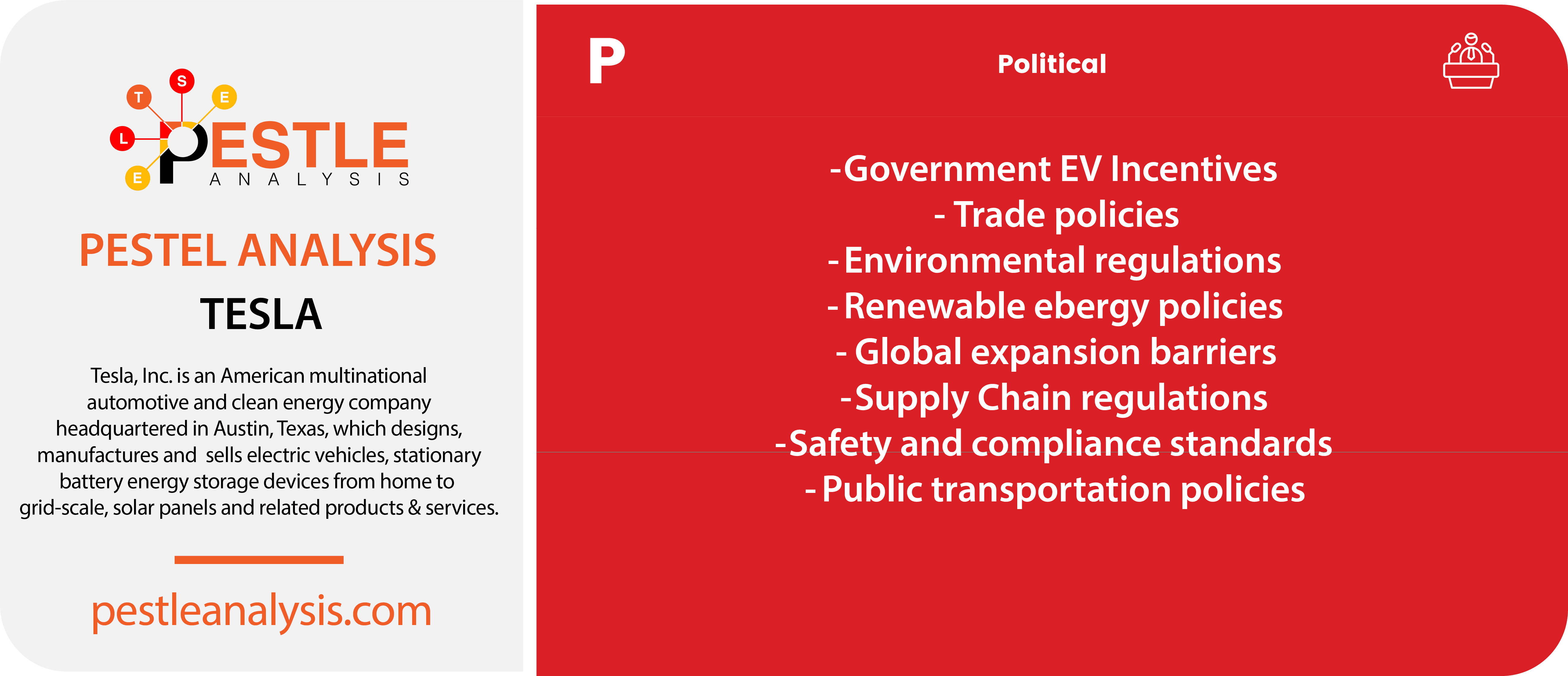
Our PESTLE analysis of Tesla starts like every other PESTLE analysis: analyzing 8 political factors that affect the Tesla company. Prepare yourself for a lot of political jargon and international policies in this part!
- Government EV Incentives: Making more people buy electric vehicles.
- Trade Policies: Increasing or decreasing costs of import and export.
- Environmental Regulations: Stricter emissions standards favoring EVs.
- Renewable Energy Policies: These very likely favor electric cars.
- Global Expansion Barriers: Political stability and foreign investment policies.
- Supply Chain Regulations: These rules affect production and manufacturing.
- Safety and Compliance Standards: Tesla is required to follow safety and environmental rules.
- Public Transportation Policies: These may compete with or complement EV adoption.
But enough talk of mundane political factors. Let’s talk about three specific political developments that acted like speed boosts (or speed bumps) for Tesla to get a better understanding of how politics can influence them.
- U.S. Electric Vehicle Tax Credits: The U.S. government has played a significant role in Tesla’s acceleration with various tax credits for electric vehicles. The extension of EV tax credits, as part of broader climate policy initiatives, has been a green light for many potential Tesla buyers, encouraging them to switch to electric. This policy not only revs up consumer interest but also boosts Tesla’s sales in the U.S. market.
- Trade Tensions Between the U.S. and China: Now, imagine Tesla cruising down the international highway, only to hit a speed bump named U.S.-China trade tensions. As Tesla expands its manufacturing and sales in China, trade policies and tariffs become crucial. The imposition of tariffs can increase costs for Tesla, affecting its pricing and competitive edge in the Chinese market, which is like trying to navigate through traffic with a flat tire.
- EU’s Aggressive Emission Reduction Goals: Lastly, let’s steer towards Europe, where the EU’s ambitious goals for emission reductions have laid down a smooth, open highway for Tesla. The European Green Deal and stringent CO2 emission targets mean that the demand for electric vehicles is set to skyrocket. For Tesla, this is like having the Autobahn all to itself – a clear path to increase its market share in Europe.
Tesla Economic Factors
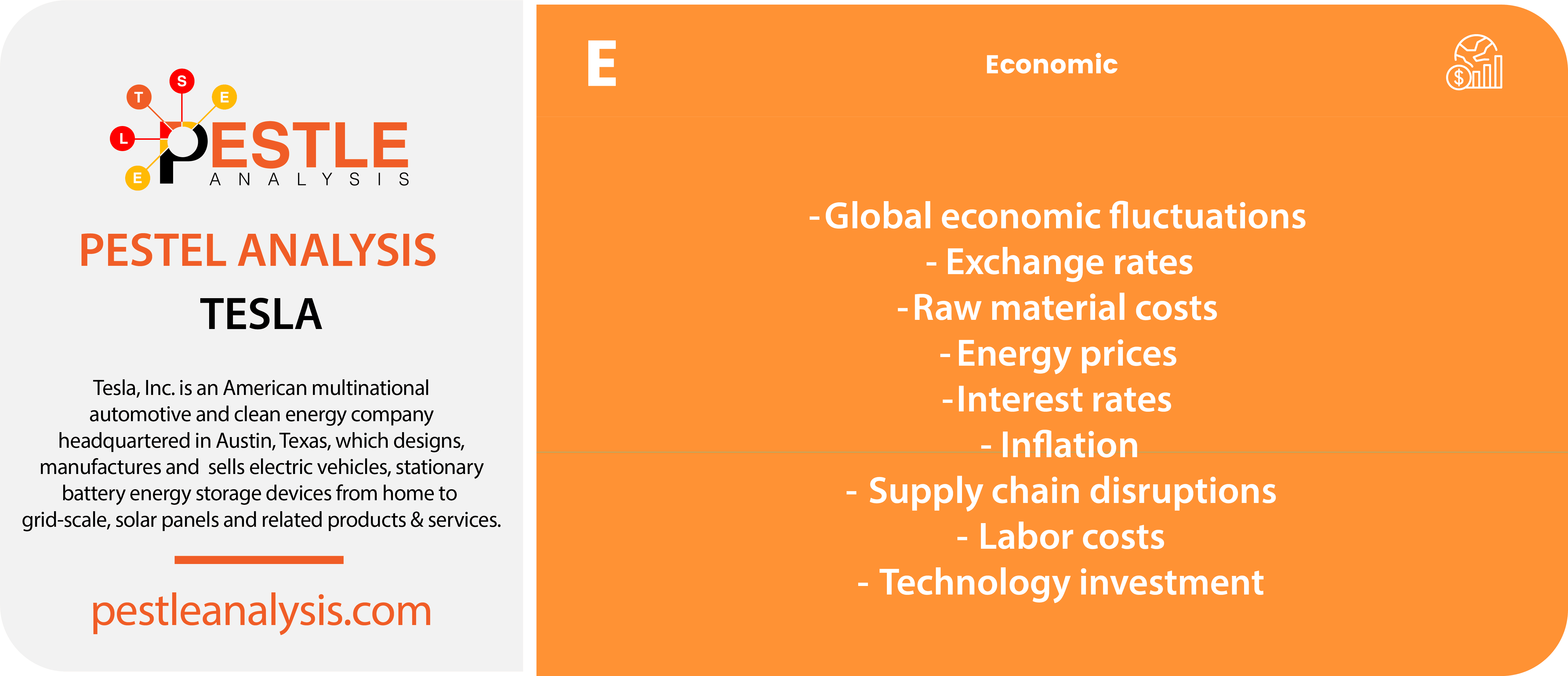
Did you know that some Tesla models feature a "Bioweapon Defense Mode," an air filtration system designed to protect passengers from biological threats?
Well, now you know and we now move into the second section of our PESTLE analysis of Tesla. Here we explore how 10 economic factors influence Tesla.
Recently, the electric car market has grown exponentially. Global electric car sales surged. They crossed over 3 million units in a single year for the first time in 2020. They nearly doubled to around 6.6 million units in 2021 and surpassed 10 million units in 2022.
This growth obviously suggests a robust and expanding market. People demand more electric cars, technology advances, and governments around the world favor EV's adoption.
What’s more, the market value of the electric car sector has skyrocketed. The industry's value is estimated to be in the hundreds of billions. In the meantime, projections point towards it reaching over $800 billion by 2027. This is because of investments in EV technology and people being more interested in greener transportation options.
- Global Economic Fluctuations: This impacts how much people can spend.
- Exchange Rates: Affecting how much the cars cost to build and their selling price.
- Raw Material Costs: If lithium is getting more expensive, battery production will cost more.
- Energy Prices: This affects how competitive EVs will be against traditional vehicles.
- Interest Rates: People buy cars on credit, so…
- Inflation Rates: As everything becomes more expensive, so will Tesla cars.
- Supply Chain Disruptions: These affect manufacturing and delivery to the customer times.
- Labor Costs: Workers don’t work for free.
- Technology Investment: Investing in technology requires Tesla’s capital.
- Market Competition: Other EV companies offering competitive prices
Now, let’s spotlight three specific economic episodes that Tesla, like a seasoned driver, had to maneuver through on its quest for electric dominance.
Economic Milestones on Tesla’s Route
- The Great Chip Shortage Detour of 2020-2021: Imagine you’re on a road trip, and you find out there’s a massive detour ahead because the main bridge is out. That’s akin to what happened in the tech world with the global semiconductor shortage. This crunch affected not just gadgets and gizmos but big players like Tesla too. With chips being the brain behind everything from Tesla's touchscreens to its Autopilot system, this shortage forced Tesla to reroute—slowing down production and even tweaking software to adapt to the chips that were available. It was a masterclass in flexibility and innovation, showing Tesla’s ability to navigate through economic tight spots.
- The Chinese Market Speed Bump: In recent years, Tesla made a bold move by establishing a Gigafactory in Shanghai, China, aiming to supercharge its presence in the world's largest car market. However, the economic terrain here came with its own challenges. From trade tensions causing tariff hikes to local competition heating up with brands like NIO and BYD, Tesla had to adjust its strategy. It was like driving on a road that keeps changing its width—you’ve got to stay alert, adapt your speed, and sometimes shift lanes to maintain your lead.
- Battery Raw Material Price Fluctuations: Now, imagine planning a road trip budget, but the gas prices keep jumping up and down unpredictably. That’s a bit what Tesla faces with the cost of lithium, nickel, and other raw materials crucial for battery production. Prices for these materials can swing wildly based on market demand, geopolitical tensions, and supply chain issues. For Tesla, managing these fluctuations is key to keeping their cars affordable for consumers while maintaining healthy profit margins. It’s a delicate balancing act, akin to adjusting your road trip itinerary on the fly to keep within budget.
Tesla Social factors
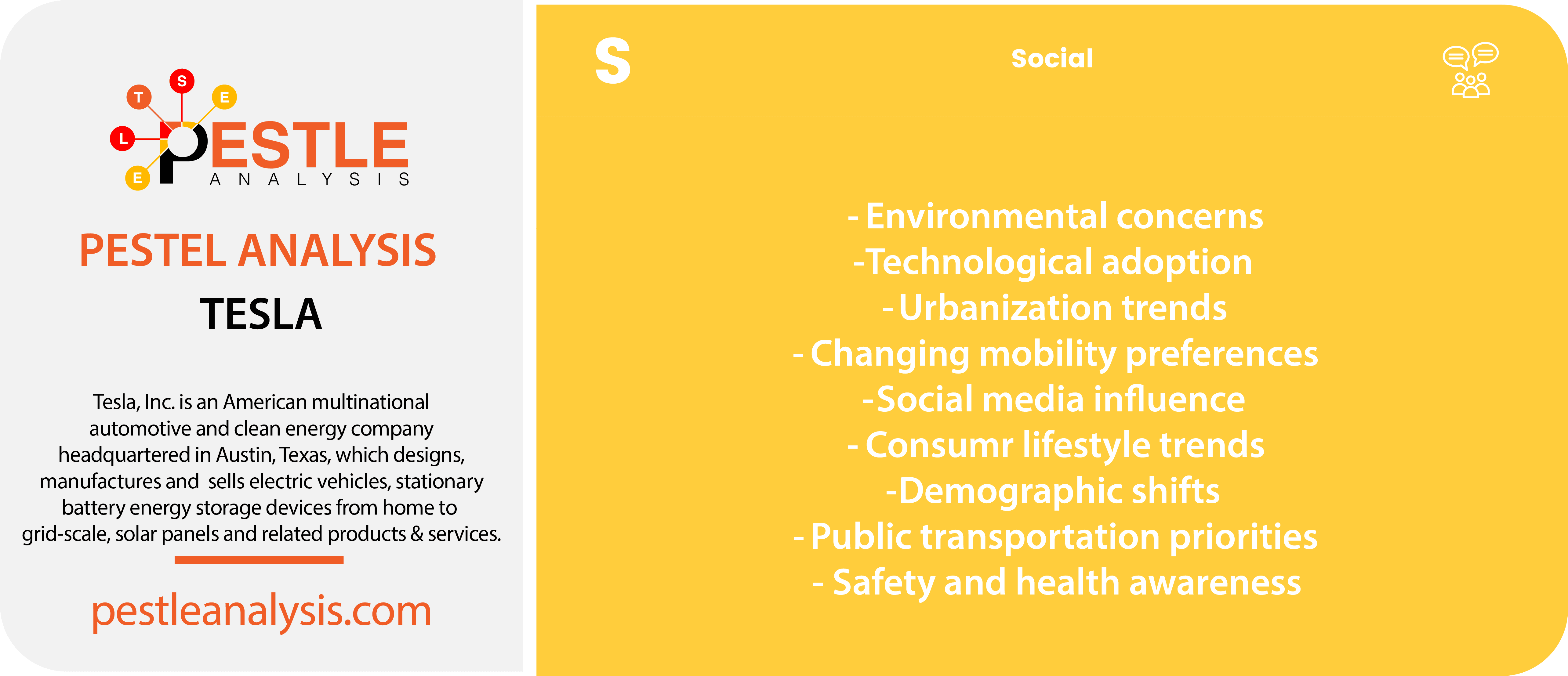
Did you know that Tesla introduced a "Dog Mode" that keeps the car at a comfortable temperature for pets inside while displaying a message to passersby that the pets are safe?
Now you know, and it's time for the third part in our PESTLE Analysis of Tesla: how 10 social factors influence Tesla. Or in other words, how connecting with people and innovation go hand-in-hand.
- Environmental Concerns: People worrying about climate change will favor electric vehicles.
- Technological Adoption: People are always eager to try out new tech.
- Urbanization Trends: As cities are getting bigger, they need sustainable transportation.
- Changing Mobility Preferences: People prefer sharing or leasing to owning vehicles.
- Social Media Influence: Elon Musk’s presence on social media, like X (formerly Twitter), have an effect on the Tesla brand.
- Consumer Lifestyle Trends: Younger generations prefer sustainable and ethically produced products.
- Demographic Shifts: Younger generations are more interested in electric vehicles.
- Public Transportation Priorities: As public transport is improved, less people will need a personal vehicle.
- Cultural Shifts: This is about the trend towards minimalism and reducing carbon footprints.
- Safety and Health Awareness: Consumers want safer, non-polluting vehicles.
Here are three specific instances where social dynamics, underpinned by compelling statistics, played a pivotal role in Tesla's story:
- The Surge of Environmental Consciousness: As the green movement accelerates, consumer preferences are increasingly leaning towards sustainable and eco-friendly products. This shift has been a significant tailwind for Tesla. For example, in 2020, despite the global pandemic, Tesla's vehicle deliveries saw a remarkable increase, exceeding 499,000 vehicles worldwide. This surge can be attributed to the growing societal push towards sustainability, with more individuals looking to make environmentally responsible purchasing decisions. Tesla, as a flagbearer of the electric vehicle revolution, benefits from this trend, as evident in its sales numbers.
- The Influence of Celebrity Endorsements and Social Media: Elon Musk’s presence on social media, particularly Twitter, has had a profound impact on Tesla’s brand visibility and appeal. His tweets not only garner extensive media coverage but have also influenced Tesla’s stock prices and public perception. For instance, when Musk tweets about Tesla or related technology, it often leads to significant buzz and discussion online, translating into increased interest in Tesla’s products. This phenomenon underscores the power of social media and celebrity influence in shaping consumer behavior and brand perception in the digital age.
- The Shift in Work Culture and Urban Mobility: The global pandemic brought about a seismic shift in work culture, with remote work becoming the new norm for many. This change has implications for urban mobility and car ownership patterns. During the pandemic, Tesla saw an uptick in interest as people started valuing private transportation more than ever. Moreover, Tesla’s emphasis on technology, such as Autopilot and Full Self-Driving capabilities, aligns with the growing consumer appetite for tech-enabled convenience in all aspects of life, including transportation. This shift in societal behavior and expectations around work and mobility further cements Tesla's position in the market.
Tesla Technological Factors
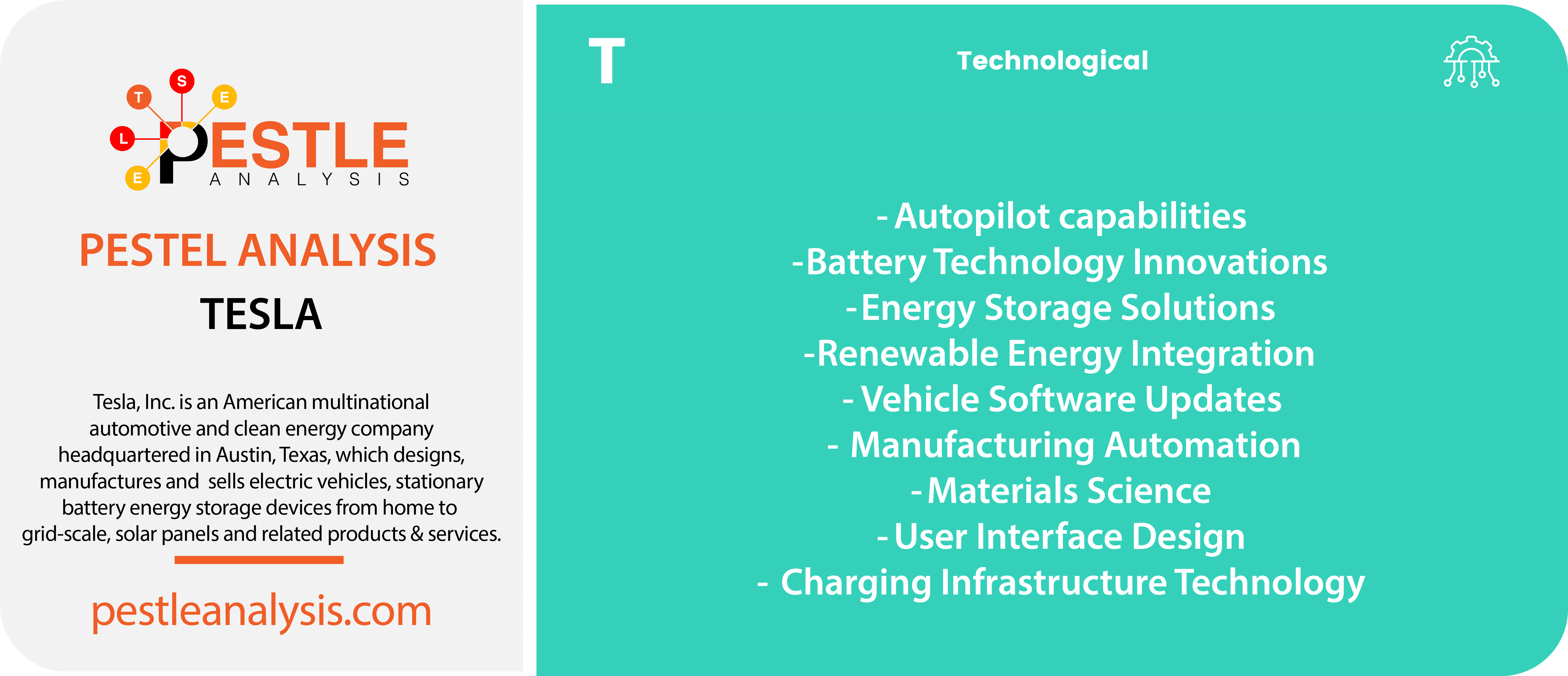
Did you know that Tesla's "Emissions Testing Mode" is essentially a whoopee cushion feature, allowing drivers to make their car emit farting sounds on command?
Now you know, and in the fourth part of our PESTLE analysis of Tesla we geek out a bit as we move into 9 technological factors affecting the Tesla brand.
- Autopilot Capabilities as autonomous driving technology is advancing.
- Battery Technology Innovations, as batteries last longer and cost less.
- Energy Storage Solutions as companies are investing in battery storage systems for homes and businesses.
- Renewable Energy Integration is making cars use solar power and other renewable energy sources someday in the future.
- Vehicle Software Updates that enhance vehicle features and performance.
- Manufacturing Automation that improves manufacturing processes with robotics.
- Materials Science as materials for vehicle construction become more lightweight and durable
- User Interface Design that changes in-car user interface and connectivity features for the better.
- Charging Infrastructure Technology that makes electric vehicles charge quicker.
Let's now explore three specific examples where technology not only propelled Tesla forward but also reshaped industry standards.
- The Revolution of the Supercharger Network: Imagine embarking on a road trip, your EV fully charged and the open road ahead. Yet, the nagging worry of "Where will I recharge?" looms. Enter Tesla's Supercharger network—an extensive, strategically placed network of fast-charging stations designed to eliminate range anxiety and make long-distance EV travel a breeze. Tesla boasts over 30,000 Superchargers worldwide, enabling Tesla drivers to recharge up to 200 miles in just 15 minutes. This network not only serves as a key selling point for Tesla vehicles but also underpins the viability of EVs for long-distance travel, setting a benchmark for the industry.
- The 4680 Cell Battery Breakthrough: The heart of any EV is its battery, and Tesla's introduction of the 4680 battery cell marked a leap forward in battery technology. Larger than its predecessors, the 4680 cell offers significant improvements in energy density, power, and range, potentially lowering costs and making EVs more accessible to the mass market. Tesla claims the 4680 cells improve range by up to 16% and reduce production costs by 14%. These advancements are crucial for Tesla's future models, including the Cybertruck and Semi, promising to enhance their performance and affordability, thereby accelerating the transition to sustainable transport.
- Autopilot and Full Self-Driving (FSD) Capabilities: Tesla's Autopilot and Full Self-Driving (FSD) technologies are at the forefront of autonomous vehicle development. By leveraging advanced machine learning algorithms and vast amounts of driving data, Tesla aims to achieve full autonomy, transforming the driving experience and potentially revolutionizing transportation. Tesla has collected billions of miles of driving data to train its systems, offering features like auto lane change, autopark, and summon. While fully autonomous driving has not yet been achieved, Tesla's FSD beta is available to selected customers, showcasing the company's commitment to pushing the boundaries of what's possible with autonomous tech.
Technology is both a friend and foe to Tesla.
As a friend, it helps the company maintain a competitive edge. It allows Tesla to be fuel efficient and paves the way for future sustainability and usability. Unlike traditional options in the automotive industry, the cars are made to adopt newer technology.
But the company also has to be on edge.
It doesn’t take much for technology to become obsolete. We are constantly creating, developing, and advancing what we already have. Thanks to upgrades and updates, the newest gadgets and apps can be absolutely useless in a year. Since Tesla relies on technology for its vehicles, this is both a positive and negative point for the vehicles.
However, Tesla is in a great Position to implement artificial intelligence (AI) and automation into their vehicles. Many traditional cars aren’t built for such advancements, but Tesla makes sure its cars are ready to adopt them (up until they advance too far).
Tesla Legal Factors
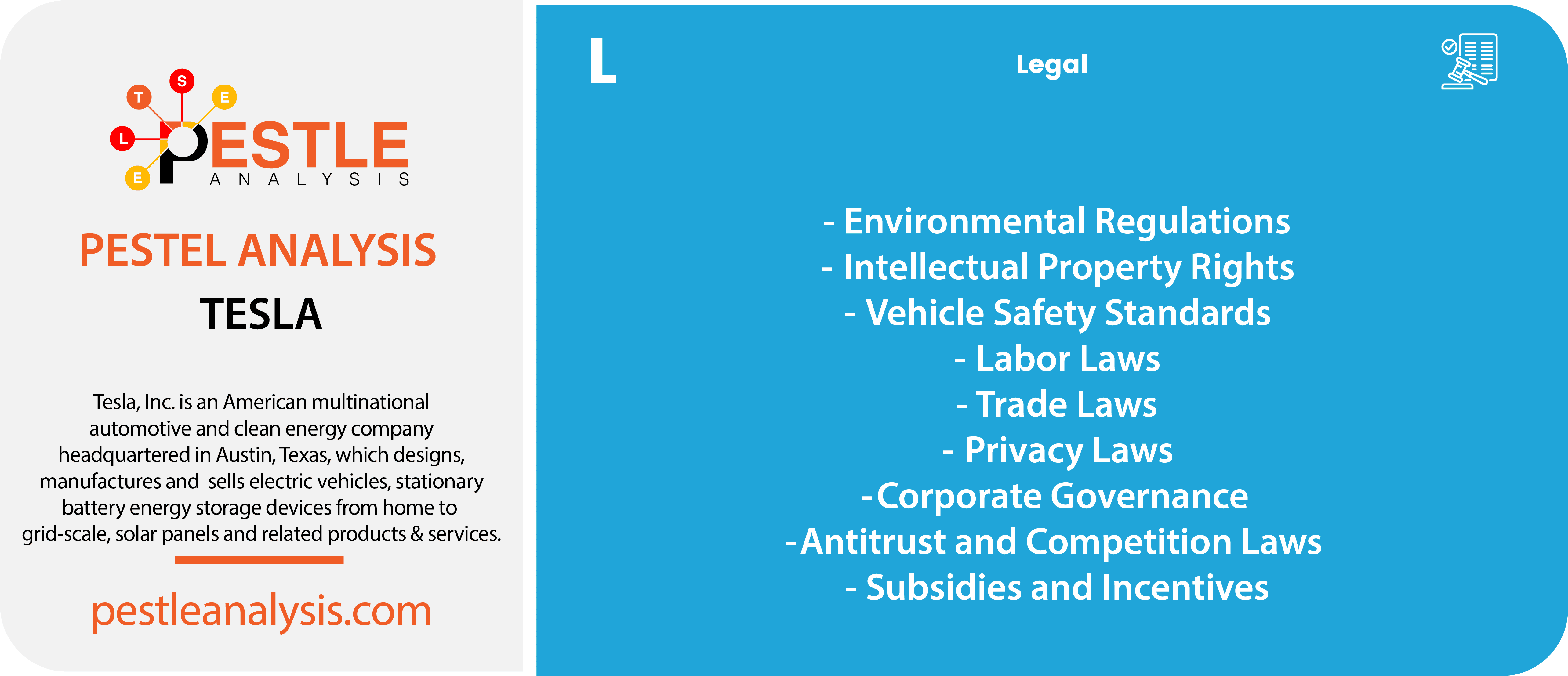
Did you know that Tesla vehicles can enter a "Sentry Mode" that uses the car's external cameras to monitor its surroundings closely to deter theft and vandalism?
Now you know, and in the fifth section in our PESTLE analysis of Tesla, we investigate 10 legal factors affecting Tesla.
- Environmental Regulations that make Tesla comply with global emissions and environmental standards.
- Intellectual Property Rights: This is about patents and trademarks.
- Vehicle Safety Standards: Because Tesla cars need to be safe, right?
- Labor Laws: Tesla workers need to work in a safe and rewarding environment.
- Trade Laws: Boring stuff, like tariffs, import/export regulations, and trade agreements.
- Privacy Laws: Because people respect their privacy and their personal data.
- Product Liability as cars catching fire doesn’t sound good.
- Corporate Governance as Tesla lives in the corporate world.
- Antitrust and Competition Laws, as Tesla must respect its competition and play a fair game.
- Subsidies and Incentives: Boring Legal frameworks that favor electric vehicles in the market.
Tesla's journey sometimes feels like going through a complex labyrinth of regulations, and legal debates. So, here are a couple of instances where Tesla had to play a high-stakes game of chess in courtrooms quite adeptly.
Legal Challenges on Tesla’s Roadmap
- The SEC Tug-of-War: One of the more headline-grabbing legal challenges involved Tesla and its CEO, Elon Musk, in a tug-of-war with the U.S. Securities and Exchange Commission (SEC). The saga began in August 2018 when Musk tweeted about potentially taking Tesla private, stating he had "funding secured." This tweet sent Tesla’s stock price on a rollercoaster and led to an SEC investigation for potentially misleading investors. The situation culminated in a settlement where Musk and Tesla each agreed to pay $20 million in fines, and Musk stepped down as Tesla’s chairman for at least three years, although he remained CEO. This episode highlighted the delicate dance of corporate governance and communication in the age of social media, showcasing the legal tightrope companies like Tesla navigate in the public eye.
- Autopilot and Safety Investigations: Tesla’s Autopilot and Full Self-Driving (FSD) systems have been revolutionary, pushing the envelope on autonomous driving technology. However, they've also attracted scrutiny from various legal and regulatory bodies. Specific incidents involving Tesla vehicles, where Autopilot was alleged to have been engaged during accidents, have led to investigations by the National Highway Traffic Safety Administration (NHTSA) and other regulatory bodies. These investigations scrutinize the safety and marketing of Tesla’s autonomous driving features, emphasizing the ongoing legal and regulatory challenges that come with pioneering new technologies. While Tesla maintains that its vehicles are safer with Autopilot engaged, these legal inquiries underscore the complexities of introducing autonomous driving technology to the public roads.
- Ongoing and Potential Lawsuits: Tesla faced ongoing legal scrutiny over CEO Elon Musk's $56 billion pay package in 2024. This includes a lawsuit in a Delaware court and potential new lawsuits. The outcome of these legal challenges could impact Tesla's governance practices and shareholder relations. The legal battles surrounding Musk's compensation package highlight governance issues within Tesla. The outcome of these lawsuits could lead to changes in how Tesla manages executive pay and board independence, potentially affecting its reputation and operational practices.
Tesla Environmental Factors: Pioneering a Greener Future
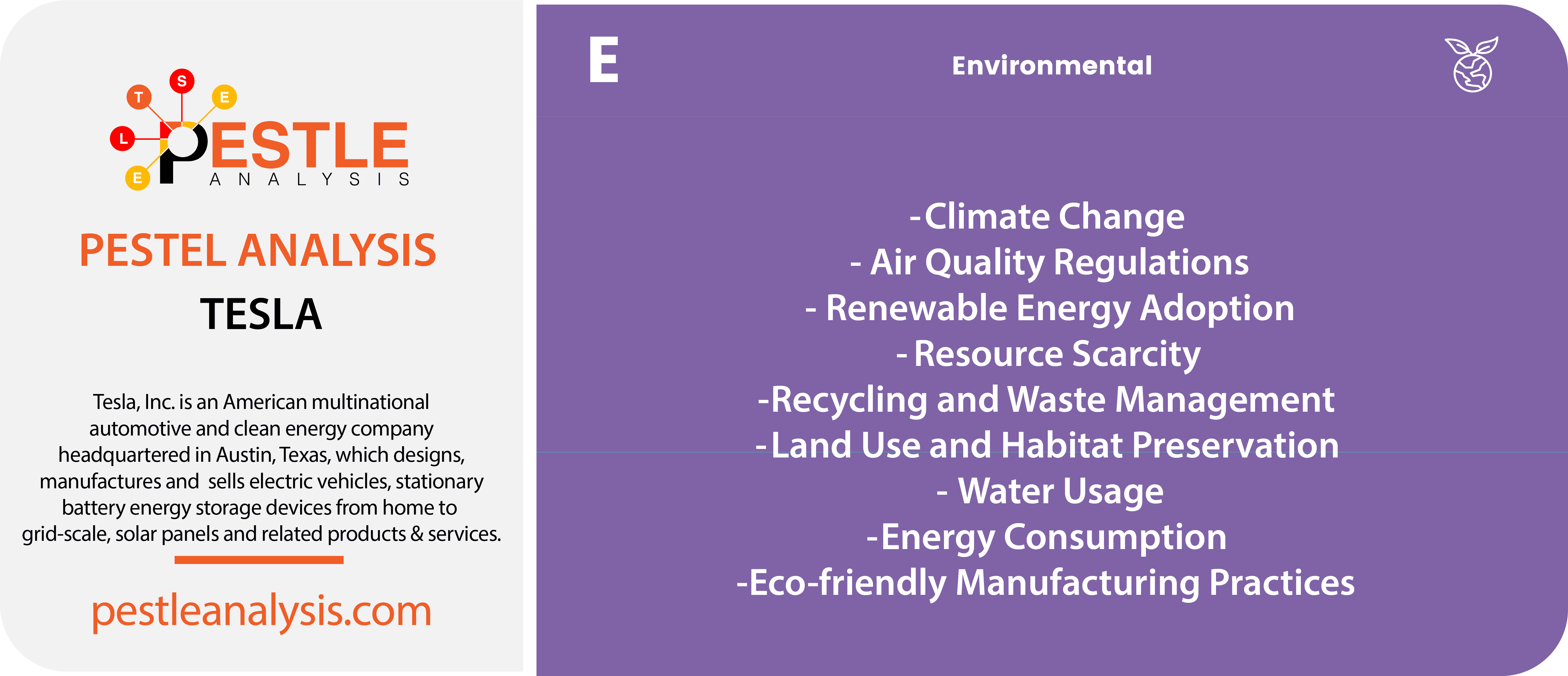
Did you know that Elon Musk, CEO of Tesla, sold branded flamethrowers through The Boring Company as a unique way to raise funds, showcasing his flair for unconventional marketing strategies?
Now you know, and in the final part of our PESTLE analysis of Tesla, we examine 8 environmental factors that influence Tesla
Tesla’s Eco Odyssey
- Climate Change since everyone is out there to reduce carbon emissions
- Air Quality Regulations that make EV’s more attractive for cleaner air in cities.
- Renewable Energy Adoption as Expansion of renewable energy sources affects EV sustainability.
- Resource Scarcity because eventually we’ll run out of lithium and cobalt for batteries.
- Recycling and Waste Management since at some point Tesla cars and their batteries will reach their end of life.
- Land Use and Habitat Preservation as manufacturing plants and raw material extraction aren’t the best for nature.
- Water Usage as people might be concerned of the water footprint during the production of an electric vehicle and its battery (or putting out a fire)
- Energy Consumption and Eco-friendly Manufacturing Practices because Tesla cars aren’t made out of thin air.
Here are two specific environmental examples that have had a significant impact on Tesla, showcasing their commitment to eco-friendly innovation.
- Gigafactory 1 – The Renewable Energy Beacon: Located in Nevada, Tesla’s Gigafactory 1 stands as a testament to the company’s dedication to sustainability. This facility, which is critical for battery production, is designed to be powered entirely by renewable energy sources. With a goal to achieve net-zero energy, Gigafactory 1 represents a significant step towards reducing the carbon footprint associated with battery production. This approach not only aligns with Tesla’s environmental ethos but also sets a new standard for manufacturing in harmony with the planet.
- The Solar Roof Revolution: Tesla's foray into solar energy through its Solar Roof tiles is another example of its environmental impact. By integrating solar panels seamlessly into roof tiles, Tesla has made renewable energy adoption both aesthetically pleasing and practical for homeowners. This innovation extends Tesla's environmental influence beyond electric vehicles, contributing to a reduction in household reliance on fossil fuels and promoting the use of clean, renewable energy sources.
Recommendations based on the PESTLE Analysis of Tesla
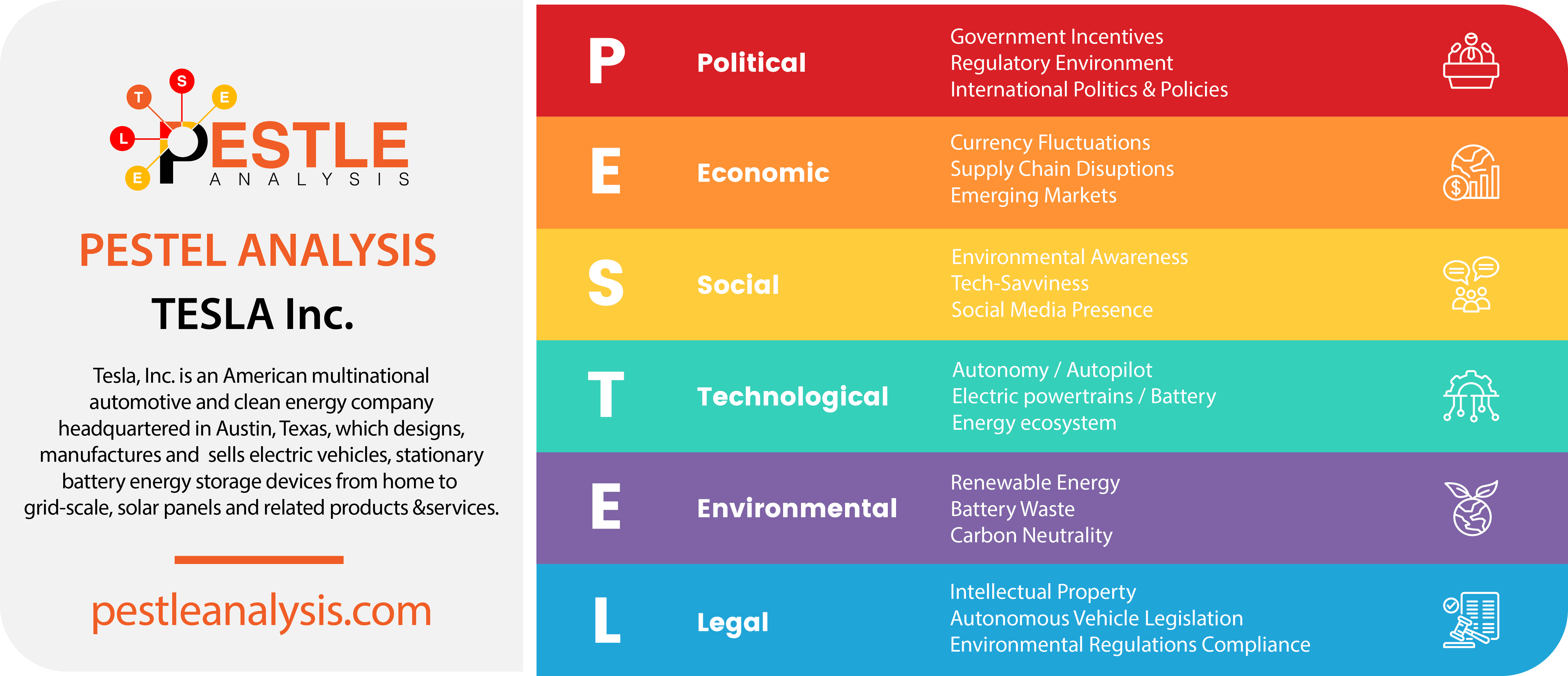
Our PESTLE analysis of Tesla has reached its final destination. It's time to provide a few actionable recommendations for the company based on our findings:
- Stay Nimble: Continue to adapt swiftly and leverage agility as a key competitive advantage.
- Innovate Responsibly: Keep pushing the boundaries of technology and sustainability, but remain mindful of the ethical and safety considerations inherent in rapid innovation.
- Engage and Inspire: Deepen engagement with consumers and the broader public, not just as customers but as partners in a shared vision for a sustainable future.
Curious about how Tesla's competitors stack up in this dynamic environment? Check out our PESTLE analyses of other leading players in the automotive industry:
- PESTLE Analysis of Toyota
- PESTLE Analysis of Ford
- PESTLE Analysis of BMW
- PESTLE Analysis of Volkswagen
- PESTLE Analysis of Mercedes
Finally, today's analysis can be used in conjunction with our SWOT analysis of Tesla. Feel free to check out more PESTLE analysis examples here and learn everything you need to know about PESTLE analysis on our dedicated page about this strategic planning tool!






